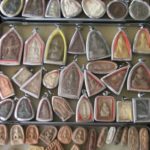Fu Talismans and Well-being
Fu talismans can be easily purchased in China. Traditionally they are made by Daoism religious practitioners but they have been available on the market for decades.
How are they used?
There are various kinds of practices. They can be placed in a high position in a space and radiate energy. They can be burnt and the energy will be released at an incredible speed. The ashes can be added to water which can be drunk by anyone who needs an improvement in the well-being. The energy that Fu contains is related to the texts on it. The talismans with different texts have different uses. The ‘efficiency’ of a same Fu talisman depends on how it is involved in the practice.
More: https://www.tinyatdragon.com/pages/how-to-use-fu-talismans-properly
Why are they used?
Fu talismans are believed to provide protection for people. Fu is a medium connecting ‘this world’ and ‘the other world’ of the dead / the spirits. Some believe that when the spirit occupies a living body, the person would be ill. Today, it is still a somewhat common practice, especially in Southern China, to drink Fu water (water with ashes to which Fu is burnt) when being unwell. The Fu is not perceived as the ‘medicine’ that can cure diseases. Rather, they prevent the spirits from attaching to the body / the place. Many in China believe that before moving into a new room or house, it is better to respect the spirits who live here and put religious objects including Fu to provide protection. If the spirits cannot live harmoniously with the living human beings, the residents will always have bad luck and their health, career, and life will all be affected. As the Chinese saying goes, ‘rather believe there is (the spirit) than believe there is not’, it is better to be safe than regret in the future.
More: https://www.scmp.com/magazines/post-magazine/article/2071221/paper-charms-and-talismans-hong-kong-better-be-safe-sorry
Additional: This is a medical report suggesting that Fu is a source of lead exposure in China
https://www.hkmj.org/abstracts/v20n4/347.htm
Contributed by JingyuanHuang on 31/01/2019





